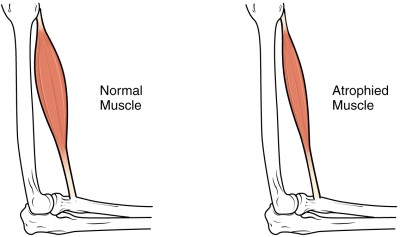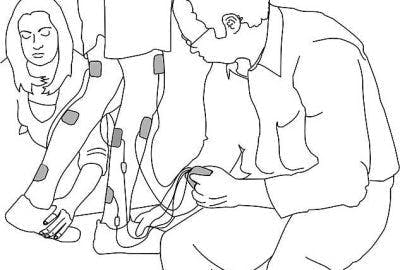People Wiith Severe Spinal Cord Injury Continue to Produce Normal Activity in the Motor
Muscle atrophy refers to the shrinking of muscles. This condition is common after spinal cord injuries because damage to the nerves can affect control over the muscles.
The body is extremely adaptive and designed to work as efficiently as possible. Everyday movements like standing, walking, and lifting objects are generally enough to maintain normal muscle mass.
However, in cases like spinal cord injury where movement can be significantly limited, the muscles shrink to conserve energy.
This article will guide you through the types, associated risks, and treatments for muscle atrophy in spinal cord injury patients.
Types of Muscle Atrophy That Can Occur After Spinal Cord Injury

Two types of muscle atrophy can result from a spinal cord injury: denervation atrophy and disuse atrophy.
Denervation atrophy describes when a nerve is damaged and can no longer trigger muscle contractions. This type of muscle atrophy is more common amongst complete or severe spinal cord injury patients who cannot voluntarily contract their muscles.
In contrast, disuse atrophy describes the shrinking of muscles caused by lack of movement. This type of muscle atrophy is more common amongst incomplete spinal cord injury patients who can still control some of their movements but for whatever reasons (depression, pain, etc.), become much less active.
Fortunately for individuals with disuse atrophy, it is always possible to regain muscle mass by increasing physical activity.
In the following section, we'll go over the importance of minimizing muscle atrophy after SCI.
Risks of Muscle Atrophy After Spinal Cord Injury
There are many risks associated with muscle atrophy after spinal cord injury.
While a little bit of muscle atrophy is expected, too much can cause serious complications, including:
- Reduced Circulation: When SCI patients sit in the same position for too long, blood cannot circulate efficiently and can pool in the legs. This increases the risk of developing blood clots and pressure sores.
- Metabolic Syndrome: When people become too sedentary, they don't use enough energy and their metabolisms slow down. Over time, this can cause high blood pressure, weight gain, and high cholesterol levels.
- Change in Body Composition: Many spinal cord injury patients initially lose weight due to rapidly reduced bone and muscle mass. However, they're also prone to increasing fat percentage over time. Changes in body composition can be harmful and contribute to the development of obesity, diabetes, and metabolic syndrome.
- Increased Injury Susceptibility: Reduced bone density and muscle atrophy cause poor balance and stability. As a result, individuals are more likely to fall and fracture weakened bones.
- Compromised Posture: Weakened musculoskeletal support can make it difficult for SCI patients to sit upright and expose certain areas of the body to excess pressure, which can limit circulation.
Now that you're familiar with the risks of muscle atrophy, let's go over how to treat it.
How to Treat Muscle Atrophy After Spinal Cord Injury
Ultimately, treating muscle atrophy after spinal cord injury requires stimulating and strengthening the muscles. Think 'use it or lose it.'
Central nerve damage cannot be reversed; therefore, recovering control after spinal cord injury is highly dependent upon spared neural pathways in the spinal cord.
Spared neural pathways have neuroplasticity, which is the ability to make adaptive changes. Through repetitive movement, the spinal cord can be rewired to recover functions weakened by SCI.
Next, we'll go over 3 effective ways to promote muscle growth after spinal cord injury.
1) Increase Physical Activity

Physical activity is the most effective form of prevention and treatment for muscle atrophy because movement requires muscle activation.
A physical therapist will assess your functional abilities, identify muscles at-risk for atrophy, and create a personalized exercise regimen.
The more you practice exercises, the more familiar their movement patterns become. Therefore, it's essential for spinal cord injury patients to practice exercises outside of their physical therapy sessions as well.
A great way to stimulate the muscles is to get into a pool (with a therapist to supervise, initially). The buoyancy of water can help reduce pressure on the joints while the viscosity of water will provide mild resistance to strengthen the muscles.
Even individuals who cannot control their movements should keep their bodies active with passive range of motion exercises. These types of exercises involve having a physical therapist or caregiver move the patient's body through their entire range of motion.
Although passive exercise generally cannot prevent muscle atrophy, it can help improve circulation and speed up metabolism.
2) Eat Healthy

By adding more nutritious foods into their diets, spinal cord injury patients can promote muscle growth and stabilize their energy levels.
Generally, a well-balanced diet consisting of proteins, carbs, and healthy fats is ideal.
Protein is essential for building and maintaining muscle mass. High-protein foods include lean meats, chicken, fish, yogurt, tofu, and nuts.
Carbs help provide quick energy for exercise. Good sources of carbohydrates include fruits, vegetables, and whole grains.
Healthy fats like omega-3s will help prevent muscle deterioration by combatting inflammation. They can be found in foods like salmon, walnuts, and avocados.
While a healthy diet alone won't build muscle, it will fuel the body with the nutrients necessary to stay energized and exercise.
3) Functional Electrical Stimulation

Functional electrical stimulation (FES) uses electrical currents to stimulate muscle contractions.
This non-invasive type of electrical stimulation involves placing electrodes on the skin over the targeted muscles and having the patient perform an activity.
For example, a physical therapist may have a patient ride a stationary bike or practice walking while the electrodes stimulate muscle contractions.
FES can provide the extra boost necessary to jumpstart movement for some SCI patients and when combined with exercise, it can strengthen the muscles and minimize atrophy.
Understanding Muscle Atrophy After Spinal Cord Injury: Key Points
Muscle atrophy after spinal cord injury is often the result of limited mobility due to nerve damage.
While a little bit of muscle atrophy is expected, spinal cord injury patients should try to move around and practice exercises that target underused muscles as much as possible to avoid negative effects in circulation, metabolism, and body composition.
Hopefully, this article helped you better understand why muscle atrophy occurs after spinal cord injury and how to manage it. Good luck!
Photos from top to bottom: iStock/kzenon/baramee2554/Lisovskaya/Milos R Popovic
Source: https://www.flintrehab.com/muscle-atrophy-due-to-spinal-cord-injury/
Post a Comment for "People Wiith Severe Spinal Cord Injury Continue to Produce Normal Activity in the Motor"